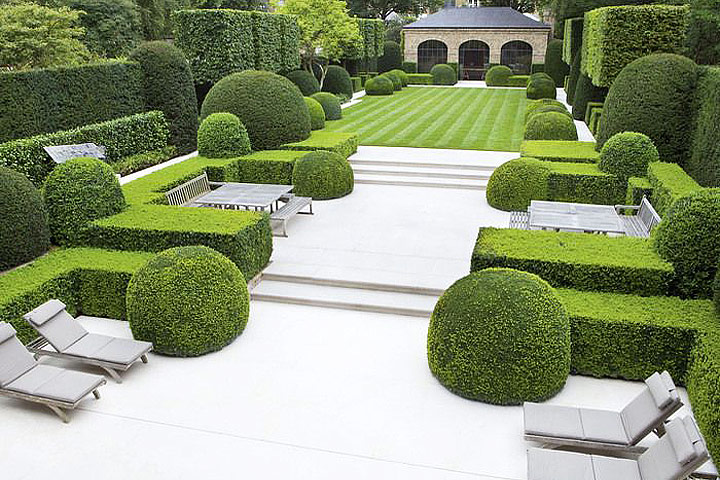
To the ancients, geometry was a formula for wisdom, a calculation that could be applied to the stars as well as elements of the earth. Geometry enabled ancient seafarers to practice navigation and it allowed ancient Egyptians to measure and predict with regularity the Nile floods. When this system of angles, ellipses, circles and squares is applied to the garden, a rational landscape is born-it need not be formal, which is a misconception of highly stylized designs-but it is well-defined. The following article discusses landscaping with geometrical and symmetrical designs for contemporary beauty based on ancient principles.
All landscapers use geometry principles to guide them in the measurement of a space. It is an essential for design. Consider the height of shrubs and trees, the dimensions of a flowerbed, the shape of a garden structure. Geometrical shapes occur without the landscaper, but to create a landscape of symmetry, the landscaper manipulates the shapes of geometry to create a stunning setting that achieves a balance and harmony between the natural elements and the elements of man. It is not merely design philosophy-it is as practical a method as digging a furrowed line for seeds.
Landscaping for Symmetry
Look at the space to be designed and note its inherent characteristics. Is it flat or hilly, overgrown or barren, boggy or dry? Your plan is not to work against nature, but to work with what you already have in the landscape. One does not set out to revamp a swamp into a southwestern garden and expect to be rewarded. In other words, it makes sense to design according to what you already have, with some reasonable modifications dependent upon your design plan.
When you are going for symmetry-you are going for a sense of balance and proportion. A long flat rectangular space will not find its compliment in a row of short shrubbery; however, tall stately trees that match the horizontal stretch with vertical height will satisfy the need for symmetry in this case.
Likewise, a hilly or sloped landscape will have its own requirements for a well-balanced look. Rather than mask the pleasant rolling of the land with tall trees and heavy foliage, show it off to its best advantage with a series of terraced flowerbeds. To relieve the horizontal flow of the beds, dissect a section with a rocky waterfall or gently zigzagging stream. Call it design by geometry or call it feng shui, it is pleasing to the eye because it is design based on principles of symmetry.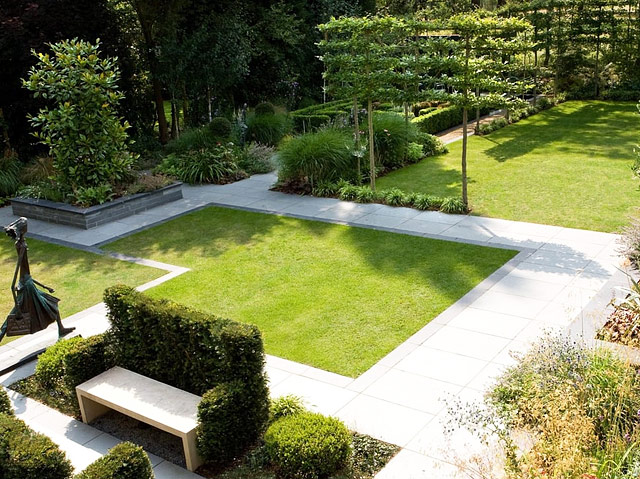
Geometrical elements of your design need not be as rigid as straight lines and right angles everywhere you look. It is simply choosing shapes and patterns that when blended, achieve a harmonious outcome. Geometric design is quite evident in highly formal gardens, but its principles can be applied to gardens of abundant growth. For example, that bog garden mentioned above will probably be challenged by aggressive plant growth-as many water gardens are, but order may be claimed by incorporating taming features that contain the growth and align each garden section to form a well-balanced design plan.
Landscaping Features
When landscaping a water garden there are a variety of features that may be arranged according to symmetrical conditions. Pergolas, arches and gazebos make excellent supports for vines and climbers and are lovely and functional structures for any landscape, but in a wet setting, they may need to be raised. Since water-loving plants are often aggressive and invasive, consider sections of built in stone planters to contain the most invasive. A simple border of stone planters may prove an invaluable divider between a manicured section of the grounds from an area of wilder growth. Also, building decking near a pond or laying a stone patio is an excellent way to add some unifying features that also help to tame the plant-growth.
Shape is a major component of garden geometrical design. Mapping out your design plan by shape is a useful way to fill in the landscape. Often, there are one or two features with properties that will govern subsequent installations. The house is generally a good guide, but perhaps there is a feature such as a natural stream or a large pond. Such features naturally influence the plan as a whole. Decks, bridges, small pavilions, etc…must be placed in accordance with these major landscape features. A couple old trees will even influence the design if they are to be kept in the plan.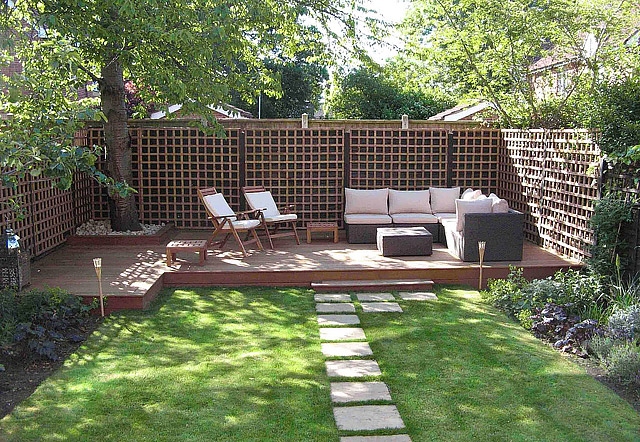
Keep in mind during this design phase that symmetry is not always tangible; try to include areas of shade as well as areas of sun. If one section of the landscape is to be busy with growth, include an area that has a large, more expansive view of the surroundings. Including a variety of shapes that work harmoniously together will often achieve the desired effect. Balance a large rectangular pond with a background of cypress trees; flank your pond with raised circular flowerbeds or perhaps a short maze of hedges leading to a centerpiece topiary or statue visible from all directions.
Geometrical Design
If the whole space is defined by a long rectangle, consider a centerpiece octagonal fountain that divides the space into two squares that may be designed as functioning separates that still manage to flow into each other. For instance, the first half may include a patio with a pergola that opens into the fountain which is followed by a small terrace garden, sections of contained plants and finally a rear wall teeming with trellises of heirloom roses or ivy. Form conforms to function in this case, but each aspect of the garden compliments the other for a well-rounded space.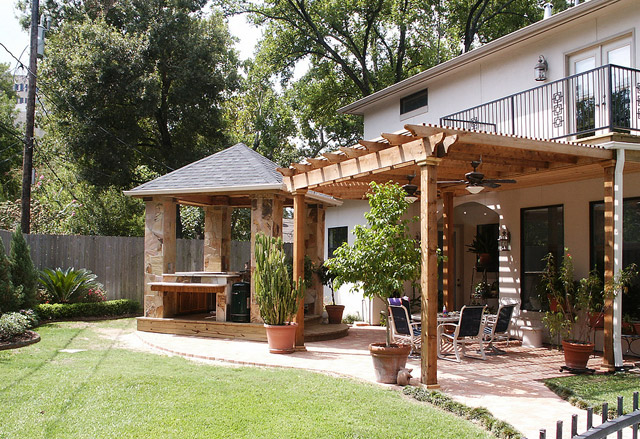
Thinking in terms of grids, lines and shapes may not be as exciting as thinking about the features themselves-the fountains, the flowers, the props, but having your shapes mapped out will enable you to fill in your design appropriately.
Knowing you need tall stately trees as opposed to dwarfish ornamentals will allow your to narrow in on a planting. Working with symmetrical shapes can even be fun-comb local flea markets for props like circular gazing balls, cylinder containers, square baskets and barrel-shaped basins.
Train your eye to look at the proportions of your space and what you want to put there; install your features with balance always in the forefront of your mind. Geometry can help add symmetrical beauty to your landscape-an ancient principle that had a hand in the Babylonian hanging gardens, but can also transform a space into the most modern and cutting-edge landscape.

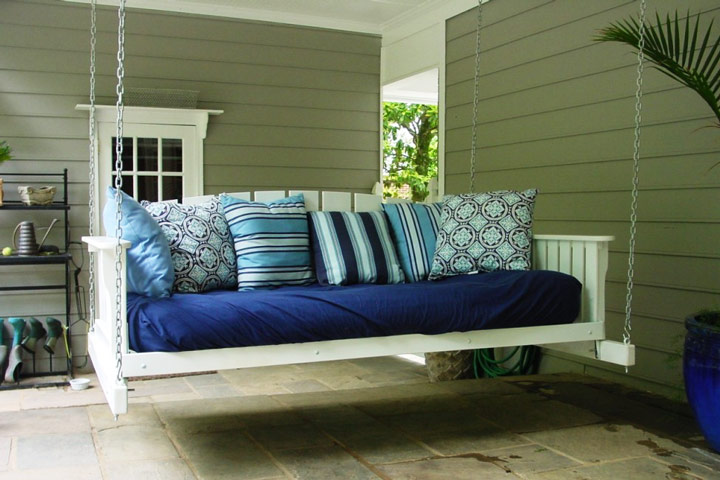


Leave a Reply